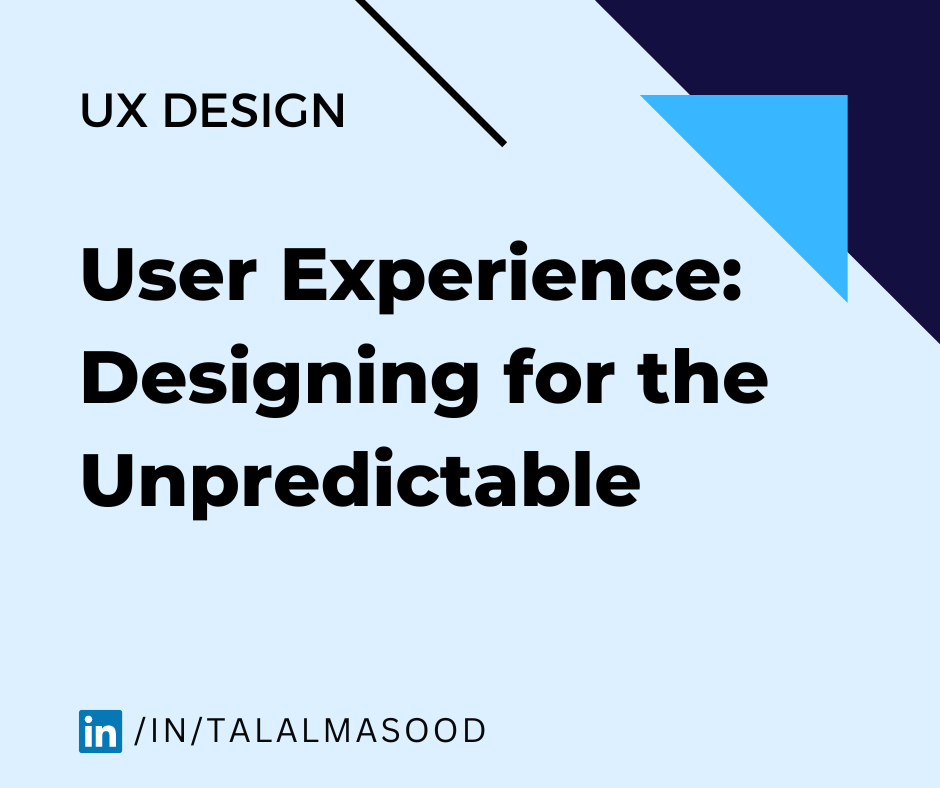As designers and developers, it’s easy to get caught up in our assumptions about how users will interact with our digital products. We create user flows, wireframes, and prototypes based on our deep understanding of user needs and behaviors, but what happens when users don’t follow the expected path? What happens when they do something unexpected or irrational?
This is where user experience (UX) design comes in. UX design is all about creating digital products that provide a positive user experience, even in unpredictable situations. It’s about designing for the user, not the designer. In this blog post, we’ll explore the importance of UX design in the face of unpredictable user behavior, and how to create a user-centered design that takes into account the entire user journey.

Understanding the User Journey
The user journey is the path that a user takes when interacting with a digital product. It starts with the user’s initial point of contact with the product, such as a website or app landing page. It continues through to the end goal, such as making a purchase or completing a task. The user-centered design takes into account the entire user journey, not just individual touchpoints.
To create a user-centered design, we need to understand the user’s needs, goals, expectations, and limitations at every stage of the journey. We can do this through user research, such as surveys, interviews, and usability testing. By gaining a deep understanding of the user, we can create a digital product that meets their needs and provides a positive user experience, even in unexpected situations.
Designing for the unpredictable
Users are unpredictable. They may not follow the expected user flow or behave in the way we anticipate. They may use a product in ways we never imagined. For example, a user may pull a hose pipe over their head to cross a pathway, instead of simply walking over it. While this behavior may seem irrational or unnecessary, it’s imperative to remember that users have their unique perspectives and motivations.
Designing for the unpredictable means creating a digital product that can accommodate a range of user behaviors and scenarios. This means being flexible and adaptable so that the product can handle unexpected situations well. For example, a website may provide clear and concise instructions for completing a task, but also include additional resources for users who may need extra assistance.
Designing for the unpredictable also means planning for accessibility. Users may have different abilities, such as visual or motor impairments, that require a different approach to interaction design. By designing with accessibility in mind, we can create a digital product that is usable by a wide range of users, including those with disabilities.
Creating a Positive User Experience
Ultimately, a successful digital product is not only functional and efficient but also delightful to use. Positive user experience means creating a product that is intuitive, easy to use, and provides value for the user. It means designing with empathy and understanding and taking into account the user’s emotional response to the product.
To create a positive user experience, we ought to plan with intention. We need to consider the user’s goals and motivations and create a product that supports those goals in a meaningful way. We need to design for clarity and simplicity so that users can easily navigate the product and complete tasks without confusion or frustration. And we have to design for delight so that users feel a sense of pleasure or enjoyment when using the product.
Conclusion
Designing for the unpredictable is a challenging task, but it’s also a necessary one. By creating a user-centered design that takes into account the entire user journey, we can create a digital product that provides a positive user experience, even in unexpected situations. We need to design with empathy and understanding and create a flexible and adaptable product that can accommodate a range of user behaviors and scenarios. And we need to design with intention, creating a product that supports the user’s goals and provides value in a meaningful way.
Ultimately, UX design is all about creating a digital product that meets the needs of the user, even when those needs are unpredictable or irrational. It’s about designing with empathy, understanding, and intention, and creating a positive user experience that delights and empowers the user. By doing so, we can create digital products that not only meet the user’s needs, but also exceed their expectations, and create a lasting impression that keeps them coming back for more.
UX design is a crucial aspect of digital product design, especially in the face of unpredictable user behavior. By designing for the entire user journey, accommodating a range of user behaviors and scenarios, and creating a positive user experience that meets the user’s needs, we can create digital products that are both functional and delightful to use. So next time you encounter unexpected user behavior, remember to design for the unpredictable and create a digital product that empowers and delights the user.






